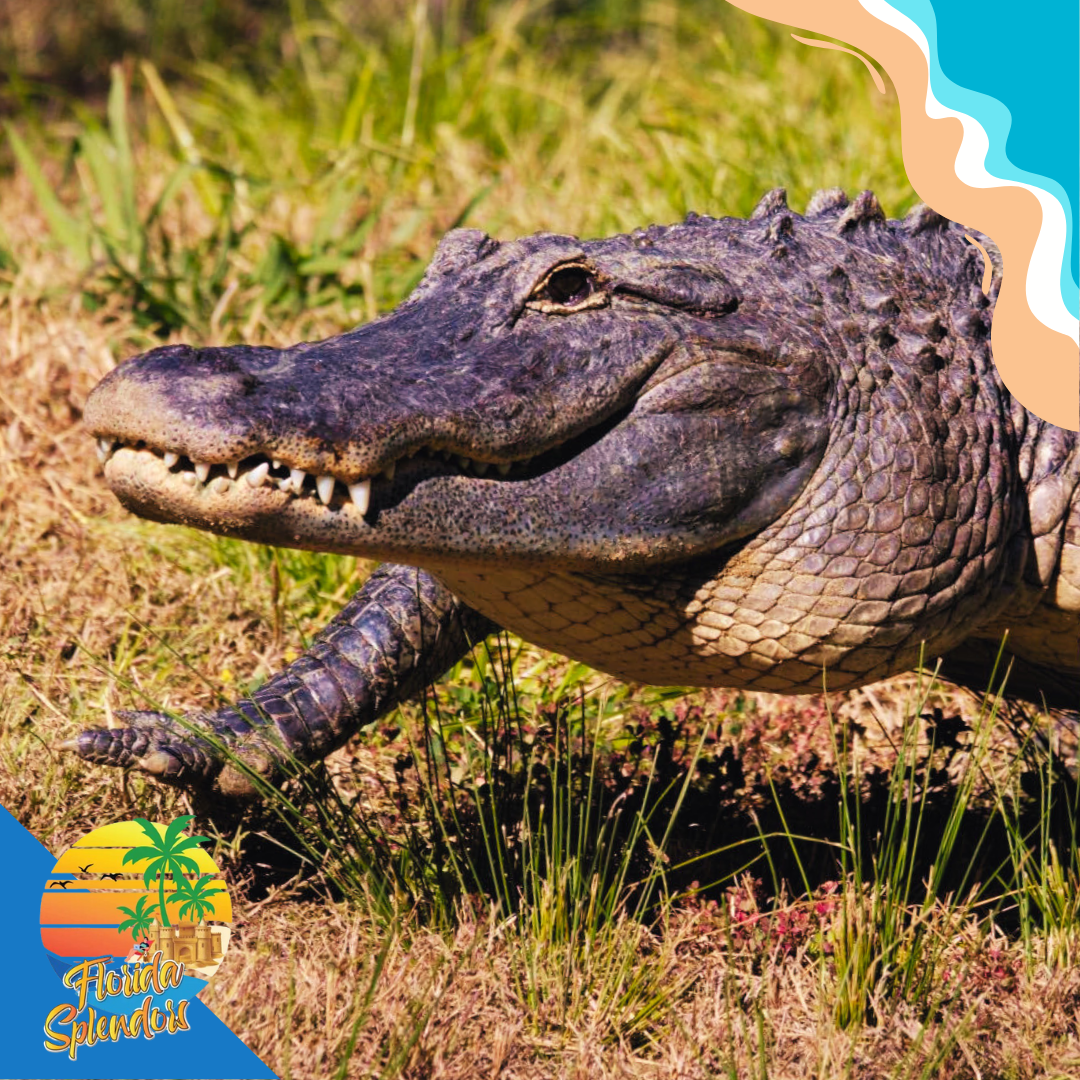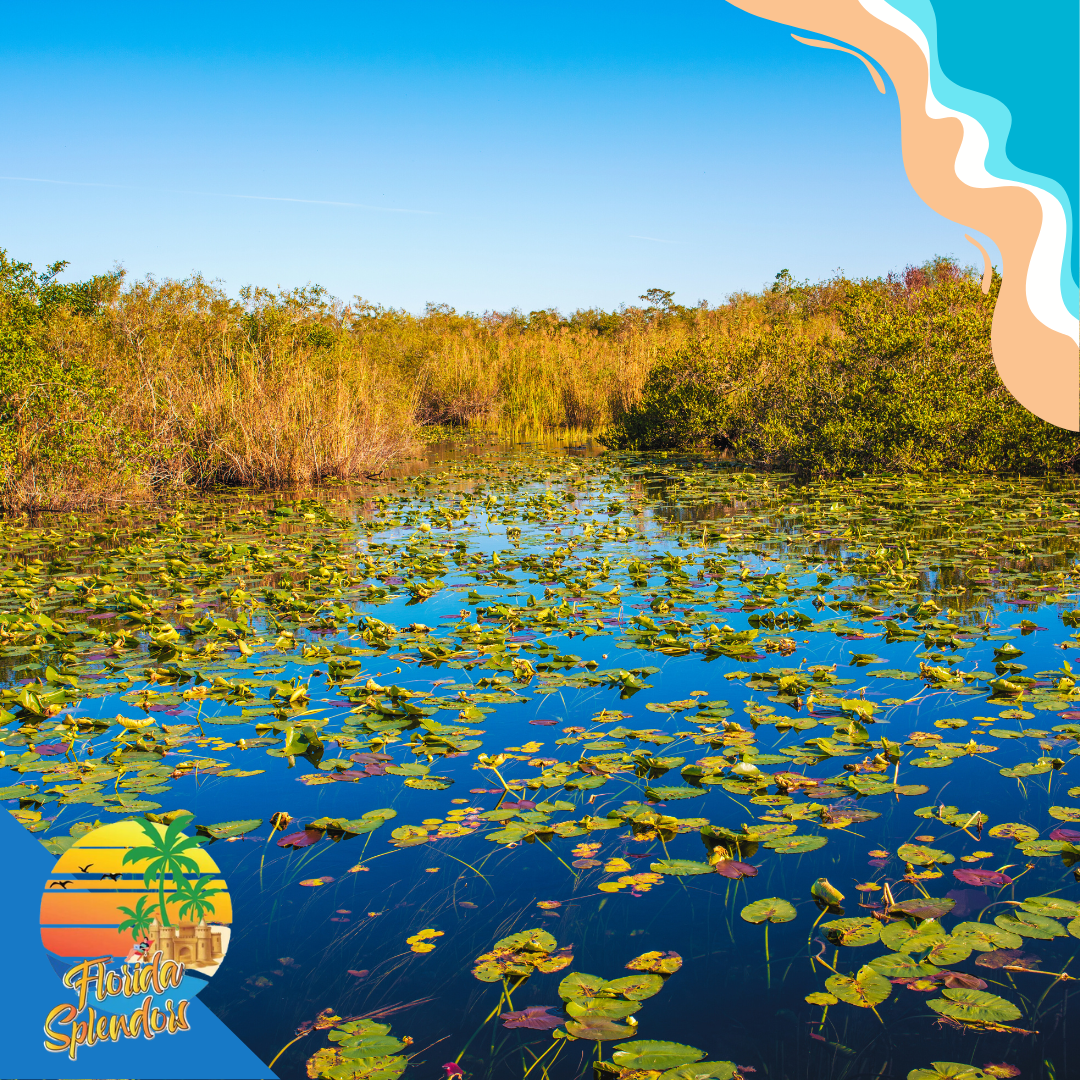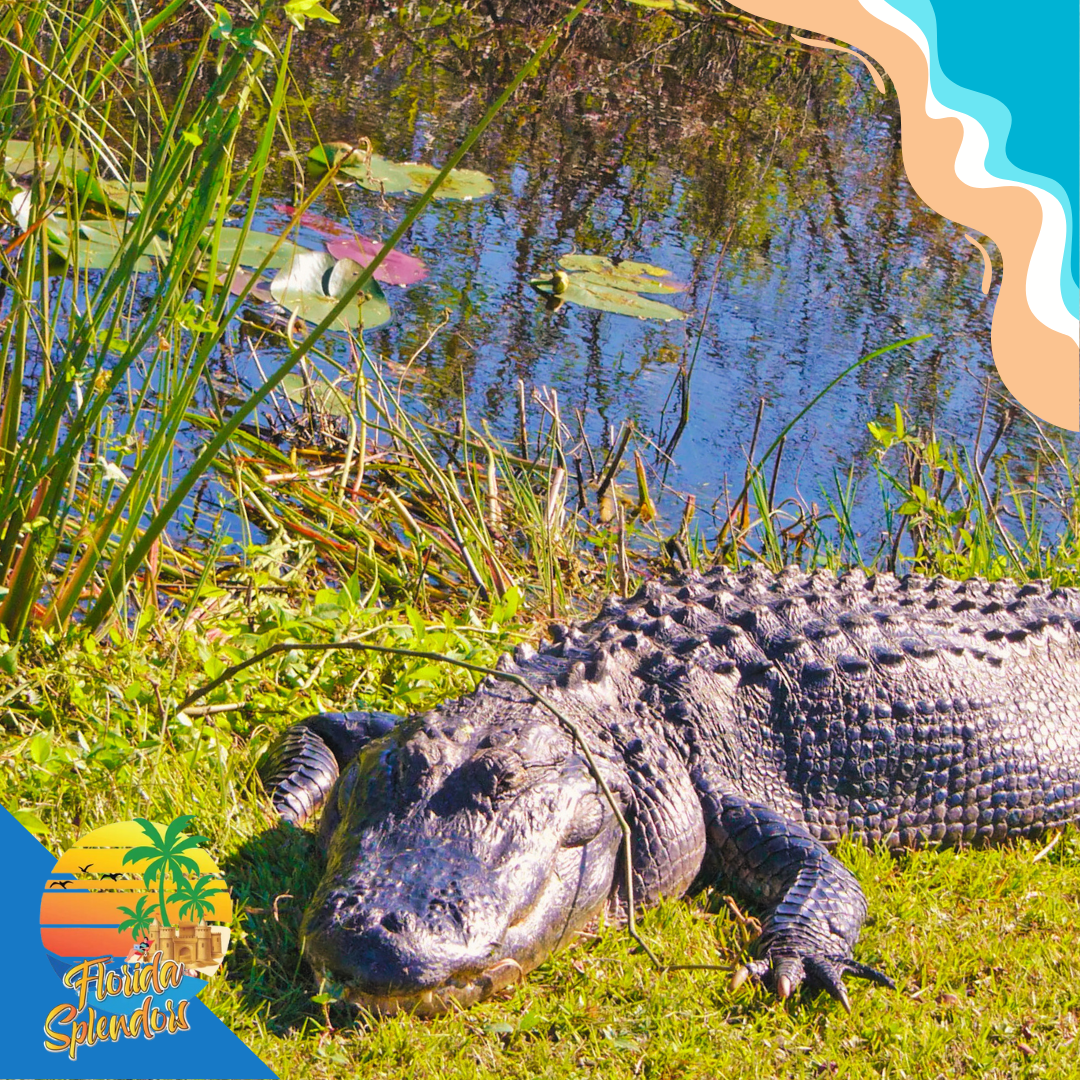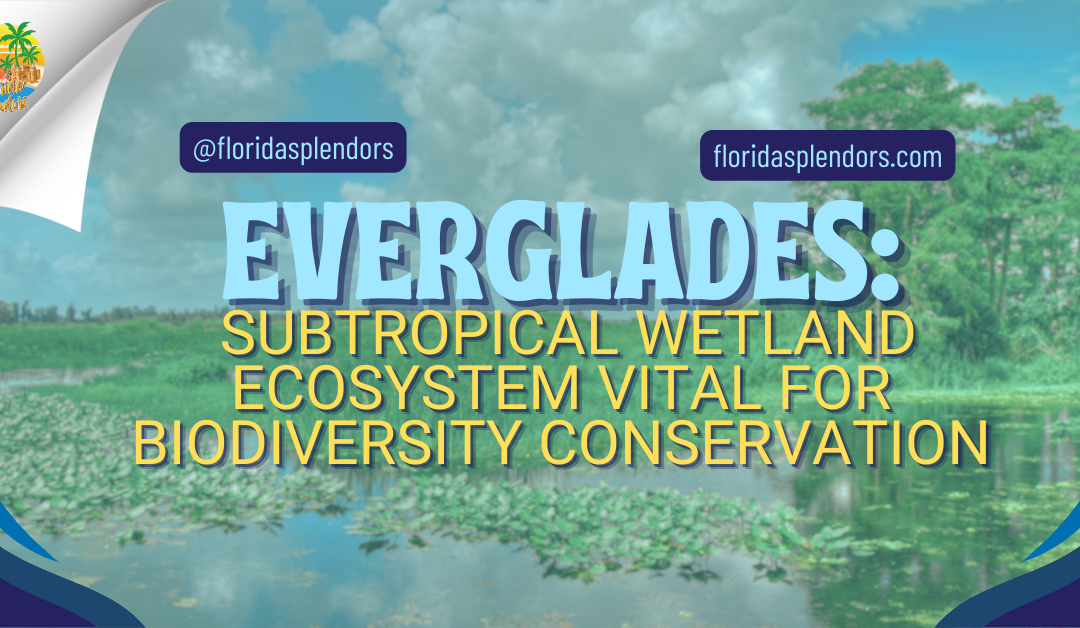==================
Florida Splendors is supported by our audience. When you purchase through one of our links, we may earn a small affiliate commission. As an Amazon Associate I earn from qualifying purchases. Your cost is not affected.
Everglades. The name itself conjures up images of a mysterious wilderness, a place where alligators lurk beneath the surface of silent rivers and exotic birds flit through dense vegetation. Having recently visited this remarkable subtropical wetland in southern Florida, I can tell you the reality is even more breathtaking. It’s a land of contrasts, where vast emerald plains of sawgrass sway in the breeze, meeting the dark, mysterious ribbons of cypress sloughs. The air vibrates with the symphony of unseen insects, occasionally punctuated by the raucous cry of a wading bird. But beneath this surface beauty lies a complex ecosystem facing a multitude of threats. From invasive species disrupting the delicate balance to the looming threat of climate change, the “River of Grass” is struggling.
There’s also a story of hope, however. Dedicated conservation efforts are underway, striving to restore the Everglades’ natural splendor. Let’s delve deeper into this remarkable ecosystem, exploring its diverse inhabitants, the challenges it faces, and the ongoing fight to preserve its irreplaceable beauty for generations to come.
Everglades: Subtropical Wetland Ecosystem Vital for Biodiversity Conservation
The Everglades, a subtropical wetland ecosystem in southern Florida, spans two million acres of sawgrass marshes, mangrove forests, and diverse waterways.
Covering more than 4,300 square miles, this unique region is sometimes called the “river of grass” due to its shallow, slow-moving waters.
The water from Lake Okeechobee flows southward, creating a dynamic environment teeming with wildlife.

The Everglades is home to numerous plant and animal species, making it a biodiversity hotspot.
With over 360 bird species, its rich ecosystems support wading birds, land birds, and birds of prey.
Various other wildlife, including alligators, manatees, and panthers, also thrive in this intricate tapestry of habitats.
The intertwining waterways and wetlands provide essential breeding grounds and feeding areas for these species.

Geographical Location and Characteristics
The Everglades is a vast subtropical wetland located in the southern part of Florida, USA.
Spanning around 4,300 square miles, the region is known as the “river of grass” due to its extensive sawgrass marshes and shallow waters.
Water in the Everglades primarily comes from Lake Okeechobee. During the wet season, the lake overflows, creating a slow-moving, shallow river that extends southward.
The ecosystem includes a mix of freshwater marshes, prairies, and mangrove forests. It forms a complex network of habitats, supporting a diverse range of wildlife.
Key Features
- Size: Approximately 4,300 square miles
- Width: Up to 50 miles wide
- Depth: Generally less than 1 foot deep
- Main Water Source: Lake Okeechobee
The Everglades is considered the largest surviving subtropical wilderness in the United States. It is fed by the Kissimmee River, which flows into Lake Okeechobee.
Unique Ecosystem
The area comprises both freshwater and saltwater regions. As water moves southward, it passes through a variety of habitats, including sawgrass marshes, hardwood hammocks, and mangrove swamps.
Being a part of the Neotropical realm, the Everglades supports a unique array of flora and fauna. Its diverse environments make it an essential ecological treasure.
For more detailed information, visit the entries on the National Wildlife Federation and Encyclopedia Britannica websites.
Biodiversity
The Everglades is a unique habitat, rich in both plant and animal life. This section highlights the distinctive plant communities and the endangered and iconic species that call this subtropical wetland home.
Flora: Unique Plant Communities
The Everglades is characterized by diverse plant communities.
The area is known for its vast sawgrass marshes, which are often referred to as the “river of grass.” These marshes are a key feature of the ecosystem, providing habitat and helping to filter water.
Various tree islands, or hardwood hammocks, dot the landscape, offering a home to a variety of hardwood species like oak, mahogany, and gumbo-limbo.
Mangrove forests thrive along the coast, playing a crucial role in preventing erosion and protecting inland areas from storm surges.
Cypress swamps are another important plant community, with towering cypress trees that can live for hundreds of years.
Finally, the Everglades supports unique subtropical pine forests, home to rare orchids, bromeliads, and ferns.
These varied plant communities create a mosaic of habitats that supports the region’s high biodiversity.

Fauna: Endangered and Iconic Species
The Everglades is home to a wide range of fauna, including many endangered species.
The American alligator is one of the most iconic residents and plays a key role in the ecosystem.
Another notable species is the Florida panther, which roams the pine forests and is critically endangered.
Birdlife in the Everglades is abundant, with species like the roseate spoonbill and the great egret. These birds depend on the wetland’s diverse habitats for nesting and feeding.
Fish and amphibians thrive in the fresh and saltwater environments.
Manatees inhabit the coastal mangroves, while the West Indian manatee can be spotted in inland waterways.
These species highlight the ecological importance and the need for conservation efforts in the Everglades.
Ecological Significance
The Everglades serves as a vital habitat for numerous species and plays a crucial role in climate and water regulation. These ecological functions are essential for the health of both natural systems and human communities in Florida.

Habitat Protection and Conservation Efforts
The Everglades provides a home for over 360 bird species, including important groups like wading birds and birds of prey.
It also supports diverse plant life, making it a biodiversity hotspot.
Efforts to restore the Everglades focus on preserving these habitats by controlling water flow and replanting native vegetation.
Conservation projects aim to curb invasive species that threaten local ecosystems. These initiatives are vital to maintaining the ecological balance and ensuring the survival of endangered species like the Florida panther.
Impact on Climate and Water Regulation
The Everglades plays a significant role in sequestering carbon, helping to mitigate climate change.
Its wetlands absorb and store carbon dioxide, making them a natural carbon sink. This function is crucial for reducing greenhouse gases.
In terms of water regulation, the Everglades helps filter and clean the water flowing through it.
By absorbing excess nutrients and pollutants, it provides clean drinking water to millions of people. It also reduces the risk of floods by absorbing heavy rainfall and releasing it slowly into the environment.
Indigenous Peoples and the Everglades
Numerous indigenous tribes have called the Everglades home for thousands of years.
The Seminole and Miccosukee tribes are among the most well-known groups with deep ties to the area. These tribes relied on the Everglades for food, transportation, and spiritual practices.
The landscape shaped their way of life. They used canoes to navigate the waterways and developed unique agricultural practices suited to the wetland environment.
These practices included growing crops like corn and beans on higher ground, while also hunting and fishing in the abundant waters.
Living in harmony with the land, these tribes left a lasting cultural imprint. Their knowledge of the Everglades’ natural cycles remains valuable for contemporary conservation efforts.
Historical Land Use and Modifications
European settlers began altering the Everglades in the late 19th century.
Large-scale drainage projects aimed to convert wetlands into farmland and develop urban areas. These efforts significantly altered the hydrology of the region.
One major project was the construction of canals and levees, which had far-reaching ecological impacts.
These modifications disrupted natural water flow, leading to habitat loss and decreased biodiversity. The establishment of agriculture and urban centers further strained the ecosystem.
Efforts in the 20th century sought to mitigate these impacts.
Conservation initiatives aimed at restoring natural water flow and protecting remaining wetlands were launched. These activities continue today, highlighting the ongoing struggle to balance human activity with the preservation of this vital ecosystem.
Invasive Species
Invasive species pose serious challenges to the Everglades. Non-native species, introduced by humans, can outcompete native plants and animals for resources. This leads to a reduction in biodiversity.
For instance, the Burmese python, native to Southeast Asia, has established itself in the Everglades. Burmese pythons prey on key species such as raccoons, birds, and even deer. This has caused a significant decline in these populations. Brazilian pepper plants spread rapidly and crowd out native vegetation, disrupting the balance of the ecosystem. Efforts to control invasive species are ongoing but resources are limited, making it a continuous struggle.
Climate Change Effects
The impacts of climate change on the Everglades are profound. Sea-level rise leads to saltwater intrusion, which harms freshwater habitats. This change in water salinity affects the plants and animals adapted to freshwater conditions.
Longer, more intense droughts reduce the availability of water, crucial for maintaining the wetlands. Increasing temperatures contribute to changes in the distribution of native species and might encourage the spread of invasive species. Restoration efforts aim to mitigate these effects, focusing on maintaining natural water flow and enhancing the resilience of native species. Without significant action, the Everglades’ unique ecosystem faces severe degradation.
Air Pollution
Air pollution in the Everglades comes primarily from urban and agricultural activities. Pollutants like nitrogen oxides and sulfur dioxides mix with rain and fall onto the ecosystem as acid rain. This lowers the pH of water bodies, affecting aquatic life.
Mercury, released from industrial activities, accumulates in fish. This poses health risks to wildlife and humans who consume these fish. Nutrient runoff from agriculture leads to algal blooms, which deplete oxygen in the water, causing fish kills and degrading water quality. Efforts to reduce air pollution focus on regulating emissions and promoting sustainable agricultural practices.
Water Flow
Water flow in the Everglades has been severely altered by human activities. The construction of canals, levees, and water control structures has disrupted the natural flow of water. This has led to areas of the Everglades becoming either too dry or too flooded, harming local wildlife and plant life.
The reduction in water flow also concentrates pollutants in certain areas, increasing their harmful effects. Restoration projects aim to restore natural water flow patterns to support the health of the ecosystem. Adjusting water management practices is critical in addressing the water flow issues.
Other Manmade Problems: Development, Industry, Agriculture
Urban growth, industrial activities, and agriculture have significantly impacted the Everglades. Development for housing and infrastructure reduces the area available for natural habitats. Industrial activities contribute to pollution through waste discharge and air emissions.
Agricultural activities introduce pesticides and fertilizers into the ecosystem. This contaminates water supplies and affects wildlife health. Fertilizer runoff leads to eutrophication, which causes dense plant growth and oxygen depletion in water bodies.
Efforts to reduce these impacts include stricter zoning laws, environmental regulations, and sustainable agricultural practices. Collaboration between government agencies, environmental organizations, and local communities is key to managing these challenges and preserving the Everglades for future generations.
Restoration Projects
Various restoration projects focus on improving water flow and reducing pollution in the Everglades.
The Northern Everglades initiatives aim to restore water storage in previously drained wetlands, achieving up to 100,000 acre-feet of natural water storage. This has positive effects on estuaries and wildlife.
Additionally, the Greater Everglades Ecosystem Restoration projects have significantly cut pollution entering the wetlands by nearly 50%. These projects have started to restore natural water flows and improve habitats, aiding in the recovery of endangered species like the Florida panther and American crocodile.
Regulatory Policies and Management
To protect the Everglades, regulatory policies and effective management practices are crucial.
Measures include monitoring water quality and controlling development around the wetland areas to prevent further damage. These policies ensure sustainable use of water resources and minimize harmful impacts on the ecosystem.
Management plans also involve concerted efforts by multiple agencies to coordinate actions.
For instance, the use of NASA satellite data helps local officials make better decisions regarding development, balancing human needs with environmental protection. These coordinated actions are key to maintaining the health and integrity of the Everglades.
Recreation and Tourism

The Everglades offers a unique mix of activities that allow visitors to explore its diverse habitats. From eco-tours to educational programs, there’s something for everyone looking to learn about and enjoy this subtropical wetland ecosystem.
Eco-Tourism and Visitor Activities
Eco-tourism in the Everglades includes activities like guided boat tours, hiking, and bird watching.
Visitors can explore the “river of grass” on airboat rides, providing close views of alligators and other wildlife. The park’s vast network of trails is perfect for hiking and biking.
Paddling through the Everglades on a canoe or kayak allows for a peaceful and immersive experience in nature. Bird watchers can spot a variety of species, including the endangered snail kite and the roseate spoonbill.
The park also offers several fishing spots where anglers can catch bass, catfish, and more. These activities support local economies and help raise awareness about the importance of preserving the Everglades.
Educational Programs and Awareness
Educational programs in the Everglades aim to inform visitors about the ecosystem’s importance and the conservation efforts in place.
The park features numerous visitor centers, such as the Ernest F. Coe near Miami and the Guy Bradley center in Flamingo.
These centers offer exhibits, films, and ranger-led talks. School groups and other organizations can participate in field trips and hands-on activities. Programs like “Junior Ranger” engage younger visitors, teaching them about the environment and wildlife.
Special events and workshops focus on topics ranging from bird identification to water management. These initiatives help foster a deeper connection and commitment to preserving the Everglades for future generations.
Scientific Studies and Data Collection
Scientific studies in the Everglades help gather essential data on various aspects of the ecosystem.
The Everglades Priority Ecosystem Sciences Program (GEPES) is a key initiative. It conducts long-term research to understand the landscape. Scientists monitor plant and animal diversity, water levels, and soil conditions.
Data collection methods include aerial surveys, water sampling, and tracking wildlife. By analyzing these data, researchers can make informed decisions to support conservation efforts. They often publish their findings, contributing to a growing body of knowledge about this vital wetland.
Technology and Innovation in Conservation
Technology plays a significant role in Everglades conservation.
Remote sensing and Geographic Information Systems (GIS) are used to map changes in the landscape over time. These tools help identify areas at risk and track the success of restoration projects. Aerial photography and satellite imagery provide detailed views of water flow and vegetation patterns.
Innovative technologies like environmental DNA (eDNA) sampling allow scientists to detect species’ presence without physically capturing them.
This non-invasive method is especially useful for monitoring endangered species. Advanced modeling software helps predict the effects of different conservation strategies, allowing for better planning and resource management.
Challenges and Opportunities
The Everglades’ ecosystem has struggled with various environmental and human-induced challenges. Urban expansion has reduced its size by about half over the past century, and pollution from agriculture continues to threaten its water quality. Climate change further complicates these issues by altering rainfall patterns and increasing sea levels.
However, there are significant opportunities for improvement. The largest environmental restoration effort in U.S. history is underway, aiming to rehabilitate the Everglades’ unique habitats.
Public awareness and scientific research are driving these initiatives, focusing on innovative solutions like improved water management and pollution control.
Projected Changes and Adaptation Strategies
Future projections indicate that climate change will continue to impact the Everglades.
Increased temperatures and changing precipitation patterns are expected to affect water levels and the health of plant and animal species. Rising sea levels could lead to saltwater intrusion, posing significant risks to freshwater ecosystems.
Adaptation strategies are being developed to mitigate these effects.
These include restoring natural water flow patterns and creating buffer zones to protect against saltwater intrusion. Policy makers and scientists are also working on adaptive management plans that can respond to ongoing changes in the ecosystem.
Investments in green infrastructure and sustainable practices are essential for these adaptation efforts. These proactive measures aim not just to preserve, but to enhance the resilience of the Everglades against future environmental challenges.

The good news is that restoration efforts are underway, offering a glimmer of hope for the Everglades’ future. However, the success of these initiatives hinges on continued public support and investment. By learning more about this remarkable ecosystem and advocating for its preservation, we can all play a vital role.
Visit the websites of the National Park Service and environmental organizations dedicated to the Everglades. Consider volunteering your time or making a donation to support ongoing restoration efforts. Let’s ensure that the symphony of the Everglades continues to resonate for generations to come.
What's Inside
- What types of animals can be found in the Everglades ecosystem?
- What are some key facts about the Everglades subtropical wetland ecosystem?
- Where exactly is the Everglades subtropical wetland ecosystem located?
- Why is the Everglades ecosystem considered important for environmental balance?
- How is the Florida Everglades ecosystem undergoing change, and what are the driving factors?
What types of animals can be found in the Everglades ecosystem?
What are some key facts about the Everglades subtropical wetland ecosystem?
This wetland is a biodiversity hotspot, housing many unique plant and animal species.
Where exactly is the Everglades subtropical wetland ecosystem located?
This unique area includes various habitats such as sawgrass marshes, mangrove forests, and coastal prairies.
Why is the Everglades ecosystem considered important for environmental balance?
Its wetlands help purify water and protect the urban areas of Miami and Fort Lauderdale from flooding.
How is the Florida Everglades ecosystem undergoing change, and what are the driving factors?
Dive Deeper into Florida’s Splendor!
Explore the magic of Florida beyond the beaches! Follow us on Facebook, Instagram, Pinterest, and Twitter for:
- Breathtaking photos and videos of Florida’s diverse landscapes, from the Everglades to the Keys.
- Engaging content about Florida’s unique wildlife, culture, and hidden gems.
- Honest reviews and recommendations for unforgettable Florida experiences.
- A vibrant community of Florida enthusiasts to connect and share your love for the Sunshine State!





